Politics- Component 3-US Constitution
1/66
There's no tags or description
Looks like no tags are added yet.
Name | Mastery | Learn | Test | Matching | Spaced |
|---|
No study sessions yet.
67 Terms
What are the three branches of government?
Legislative (Congress), Executive (President), Judiciary (Supreme Court)
What is the federal government made up of?
Made up of three branches (so are all state governments). Each one is supposed to prevent the other from exercising too much power
The US Constitution is codified and entrenched. What doe this mean?
The Constitution is written down in one document. A system by which the US Constitution is protected from changing, by law; in this case the Amendment Process of Article V
The first and second congenital congress
Each of the 13 colonies sent delegates to discuss their response to British taxes. They decided to boycott British goods. Then Britain attacked Boston. After this the 13 states set up an army and signed the Articles of Confederation. (the first US constitution)
What were the aims of the Articles of Confederation?
To organise the War of Independence
To ensure 13 states could still govern themselves whilst working together
Allowing free movement
Allowing free trade
Why didn’t the Articles of Confederation work out?
Congress was not strong enough to enforce law or raise taxes
This meant it could not repay their debts from the revolutionary war
This led to a revolt by former soldiers who wanted their pay, bringing down the government in Massachusetts
Many recognised there was need for a stronger government but feared a return to tyranny of a monarchy
What is the Constitutional Convention?
The 13 states sent delegates to Philadelphia
They agreed there was a need for a strong central government.
They also agreed it would need to be controlled to protect the people from tyranny.
What is the Checks and Balances system?
The division of power between the three branches of government where each branch has a direct ability to prevent action from another branch. (stop one another from over-reaching.
Legislative branch
Primary Role: Makes laws.
Structure:
Senate: 100 members (2 per state).
House of Representatives: 435 members (representation based on state population).
Key Powers:
Drafts, debates, and passes laws.
Controls federal budgets and taxation.
Declares war.
Confirms appointments (Senate) and ratifies treaties.
Executive branch
Key Components:
President: Head of State, Commander-in-Chief of the Armed Forces, and leader in foreign policy.
Vice President: Second-in-command and President of the Senate (votes in case of ties).
Cabinet and Agencies: Help execute policies and manage federal programs.
Key Powers:
Signs or vetoes laws passed by Congress.
Issues executive orders (directives for managing the executive branch).
Oversees federal departments (e.g., Defense, Education).
Negotiates treaties and appoints judges and officials (with Senate approval)
Judicial branch
Primary Role: Interprets laws and ensures they are consistent with the Constitution.
Structure:
Supreme Court: Highest court, with nine justices.
Lower Federal Courts: Handle specific cases under federal law.
Key Powers:
Reviews laws and executive actions for constitutionality (judicial review).
Resolves disputes between states or involving federal laws.
Protects individual rights under the Constitution.
Why did the Framers separate power into the three branches of Government?
The framers wanted limited government – the government would do only what was essential, leaving the citizen’s rights and freedoms as untouched as possible.
The Founding Fathers were fearful of one branch being too powerful > prevent “tyranny”
No person can be in more than 1 branch of the government (unlike the UK)
The founding fathers set up a system of checks and balances to stop one branch having too much power.
The ‘separate powers’ are really ‘shared powers’
‘Professor Richard Neustadt: ‘The Constitutional Convention of 1787 is supposed to have created a government of “separated powers”. It did nothing of the sort. Rather, it created a government of ‘shared powers’’
Each branch needs to operate with the consent or support of the other branches
James Madison stated what?
"The preservation of liberty requires, that the three great departments of power [executive, legislative and judicial] should be separate and distinct.“
J. Reuben Clark, Jr. stated what?
“It is this union of independence and dependence of these branches -- legislative, executive and judicial -- and of the governmental functions possessed by each of them, that constitutes the marvelous genius of this unrivalled document.”
Powers divided between branches.
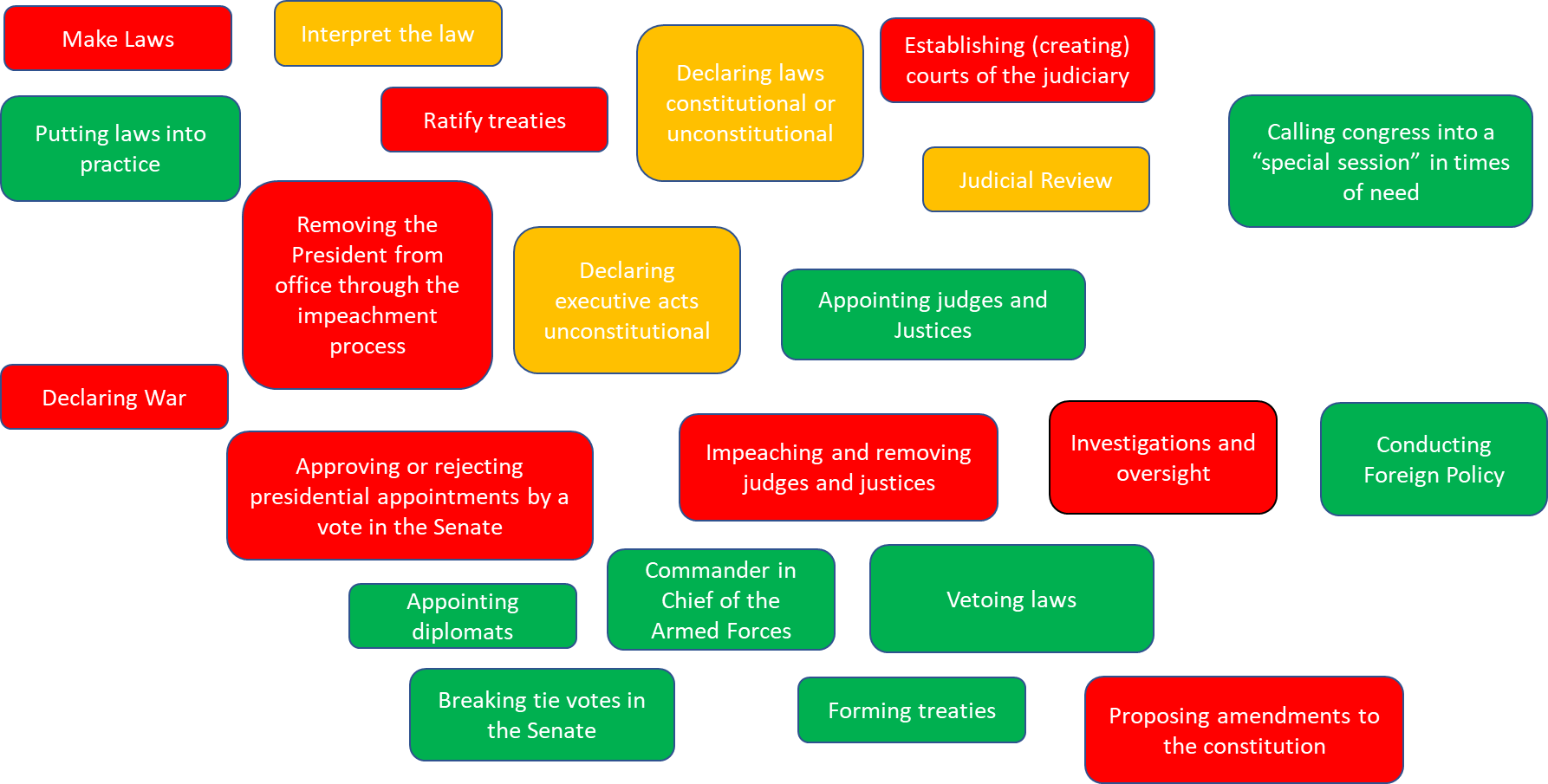
Necessary and Proper “The Elastic Clause”
“The Congress shall have Power to…provide for the common Defence and general Welfare of the United States”
“To regulate Commerce with foreign Nations, and among the several States, and with the Indian Tribes”
“To make all Laws which shall be necessary and proper for carrying into Execution the foregoing Powers, and all other Powers vested by this Constitution in the Government of the United States, or in any Department or Officer thereof.”
What does the elastic clause do?
gives implied powers
Super-majority
the two-thirds majority needed for major changes e.g. Senators voting on impeachment or for constitutional amendments by 2/3 approval in both chambers of congress and ¾ state legislatures.
The basics- Congress
535 Legislators = 100 Senators (2 per state) + 435 Representatives (divided by population)
Legislation must be approved by both houses
Representatives are elected every two years
Senators are elected every 6 years on a rotating cycle
Can vote to impeach a president for ‘high crimes and misdemeanours’
Holding congressional investigations
The basics- Executive
The President plus the executive bodies which report to the president
Manages Executive agencies such as State Department, Defence Department, Justice Department,
Negotiates Treaties
Conducts Foreign Policy
Creates independent executive administrations, such as CIA, EPA, USPS, but does not manage them
The basics- Judiciary
The Supreme Court plus the Federal Courts of each state
Conducts Judicial Review to decide if the laws passed by Congress or the executive orders of the executive are constitutional
Requires a law suit to be filed in order to act
What does Article 1:6 do?
makes clear that a Member of Congress cannot hold a position in another branch of government
So what can Congress do, specifically? According to Article 1:8, The enumerated powers of Congress.
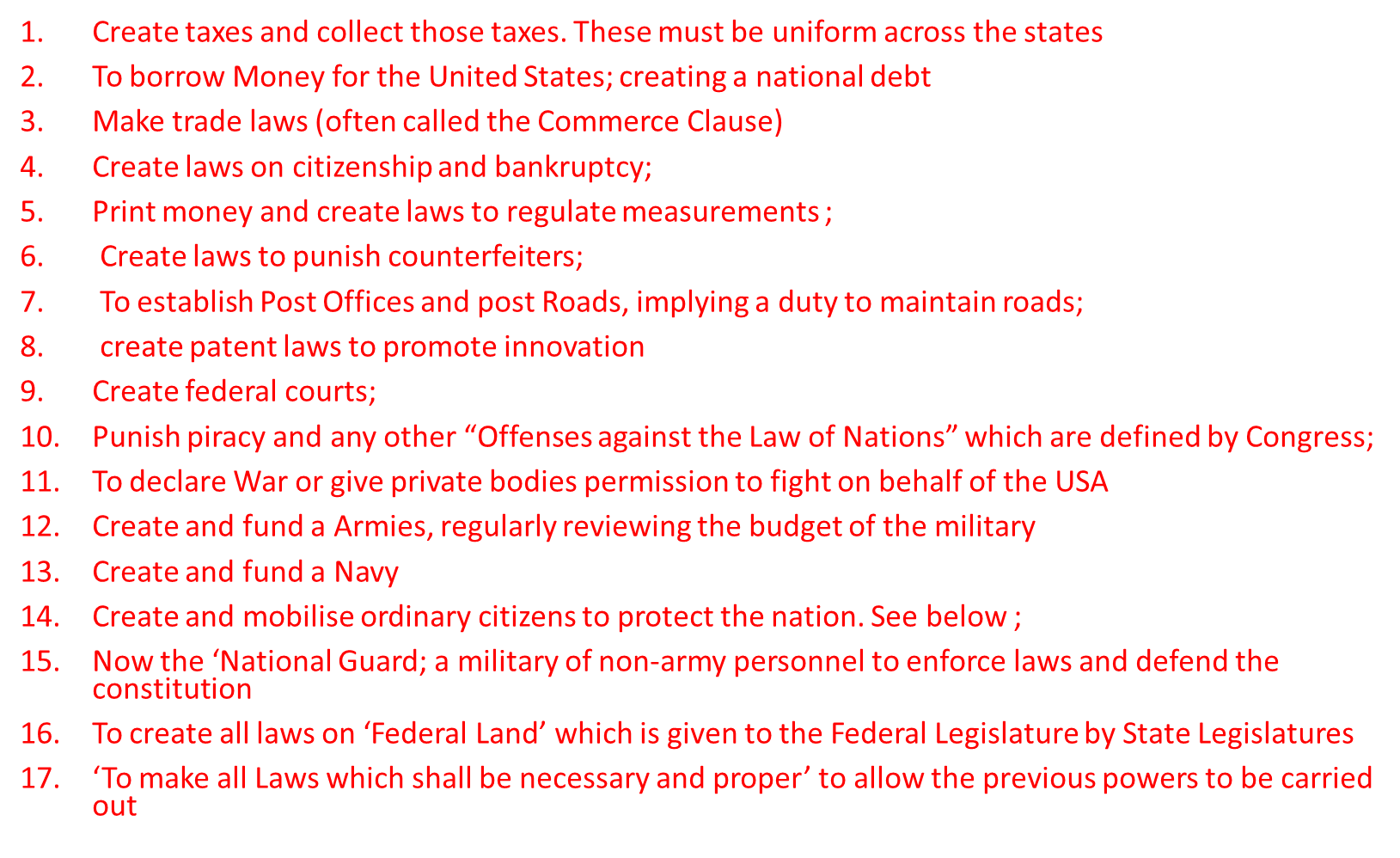
The House and taxes
“All Bills for raising Revenue shall originate in the House of Representatives; but the Senate may propose or concur with Amendments as on other Bill”
Based on the idea “no taxation without representation”
The House of Representative was directly elected, the Senate was not
Partisanship
A situation in which congresswomen and men are incredibly loyal to their party, even if this results in gridlock
Republican Party – the Grand Old Party (GOP)
Founded with the aim of abolition. Abraham Lincoln was first Republican president.
Socially Conservative
Economically liberal
Small government
Interpret the constitution to the benefit of business and power with the state governments
Voters are older, whiter and more rural
Democratic Party – ‘The Democrats’
The Oldest US Party-Founded by Thomas Jefferson (2nd US pres.)
Socially Liberal
Economically regulatory
Big government
Interpret the constitution to the benefit of individuals and power with the federal government
Voters are younger, more diverse and located in cities
Bipartisanship
attempts within the structure of the US Congress to ensure that the two main parities must work together to fulfil Congressional functions
The Bipartisan Structures of congress
Originally meant to ensure the voice of minorities were not lost, for the original framers this was the minority voice of small states.
Now the minority voice is that of Republican voters
The Democrats consistently receive more votes, but a smaller share of seats in the House, Senate and state government
Two of the last four presidents have been elected despite losing the popular vote, both were Republican
Why might the Separation of Powers not necessarily ensure checks and balances?
Three supreme court judges were appointed by president trump.
President Obama had a 60% majority to support his presidency in both chambers of Congress.
What does divided government create?
Divided Government creates weak government
If congress differs from the executive in party allegiances, there is a risk that no legislation is passed
The same is true if the Houses of Congress are from different parties
Example of checks and balances functioning as intended- Roosevelt and packing the supreme court
Roosevelt had New Deal legislation passed at his request in Congress. He had been re-elected for a second term as president. The Supreme Court was more conservative than him or Congress. It was repeatedly striking down his legislation, which he, and Congress, argued was ‘necessary and proper’ for the welfare of Americans. Roosevelt considered ‘packing the courts’ to get control.
The Democrat Senators in Congress refused to approve their Presidents request to add Justices to the Supreme Court.
Checks and Balances in conflict
There is a conflict when it comes to war. Both the President and Congress have constitutional claims to control during war
Congress passed the War Powers Act in 1973. In response to the Korean War and the Vietnam War, where the President had acted without Congressional approval.
President Richard Nixon vetoed the Act calling it an “unconstitutional and dangerous” check on his duties as commander-in-chief of the military.
Congress overrode his veto
The War Powers Act, says the president has to consult with Congress when deploying American troops. If, after 60 days, the legislature does not authorize the use of U.S. forces or declare war, the soldiers must be sent home.
However… Congress has had no power to force the President to follow the War Powers Act so he ignored it.
More Checks and Balances in conflict
President Ronald Reagan deployed military personnel to El Salvador in 1981 without consulting Congress.
President Bill Clinton continued a bombing campaign in Kosovo beyond the 60-day time in 1999.
In 2011, President Barack Obama initiated a military action in Libya without congressional authorization.
Congress has had no power to force the President to follow the War Powers Act
Example of checks and balances being used for partisan advantage
President Obama had ten months before the end of his second term (eight before the election)
Congress, both the House and Senate were controlled by Republicans
A Supreme Court vacancy came up, Obama nominated Merrick Garland.
The Senate refused to confirm Garland as a Justice. They claimed this was following precedent, but it was obviously done for partisan reasons.
The Executive was prevented from carrying out one of its functions by the partisan nature of the legislature.
What are the advantages of having a codified constitution?

What are the disadvantages of having a codified constitution?

The Bill of Rights - The First 10 Amendments to the Constitution
This protects the basic rights and freedoms of Americans.
THese rights and freedoms were present in many state constitutions but had been left out of the constitution of the US. It was thought that state constitutions would protect these rights. Over time Anti-Federalists successfully campaigned for the inclusion of a Bill of Rights in the US Constitution.
Why was a Bill of Rights needed?
Patrick Henry was one of the most critical of the new constitution.
He is one of the Anti-Federalists who wrote anonymous criticisms of the constitution.
He convinced many, including Thomas Jefferson a Bill of Rights was needed to protect the freedom for American citizens from government.
Bill of Rights
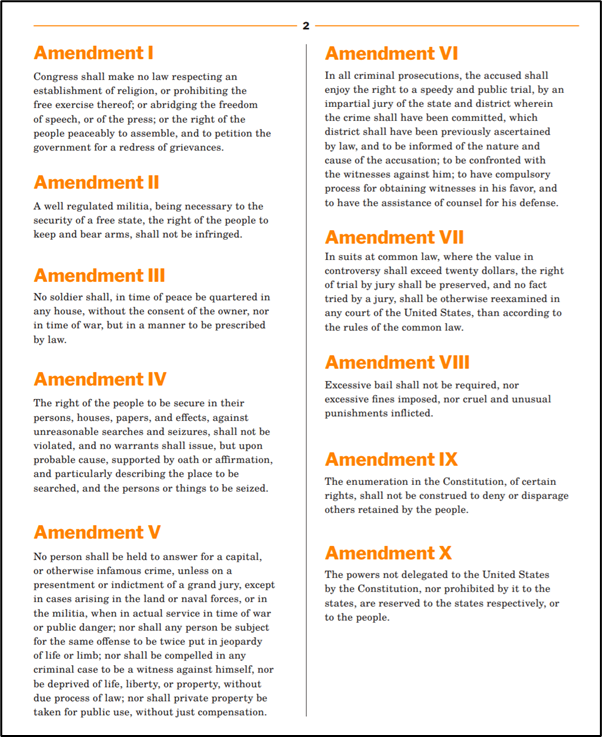
The Process for Amendments (in reality)

Federalism
The US system in which sovereignty is shared between a central government (federal government) and the individual states, with each having their own specific rights.
Devolution vs Federalism
Federalism authority is decentralized.
There are many centers of power.
Unlike devolution this power is not given.
Devolution = The dispersal of power, but not sovereignty, within a political system.
The power is shared but not the authority in devolution, this means central government can take back the powers given to devolved administrations.
In Federal systems both Federal and State governments have authority
Federal vs State
The Federal Government is the national government (President, Congress, Supreme Court)
States have their own legislatures, executives and courts
All states have the same powers, they may use them in different ways but if one state has a power, they all have this power.
Federal-State relationship
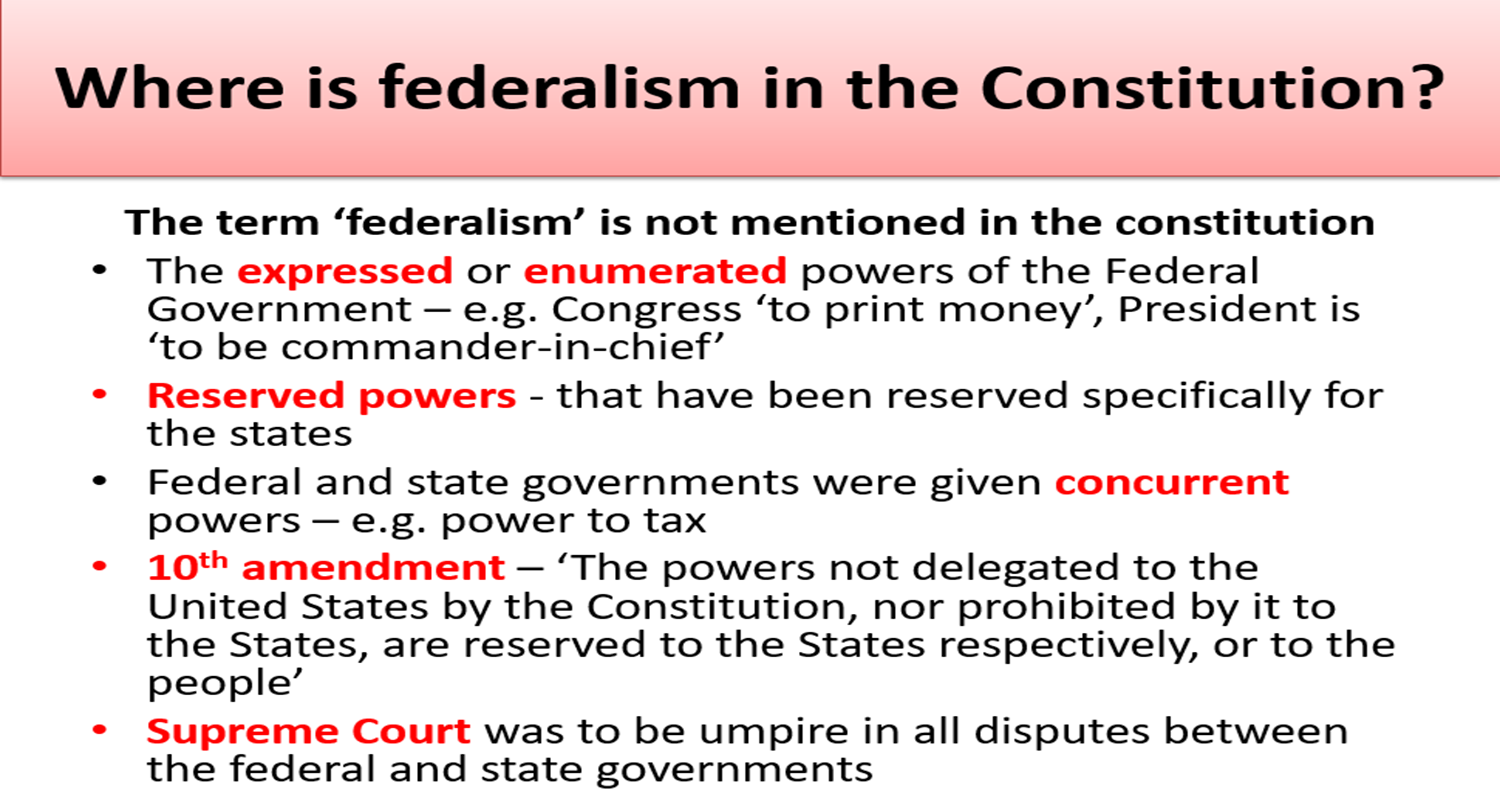
Federal powers
Power held by the national government
Concurrent powers
Power held by the national government and state government.
State powers
Power held by the state government
National powers
State powers

Powers
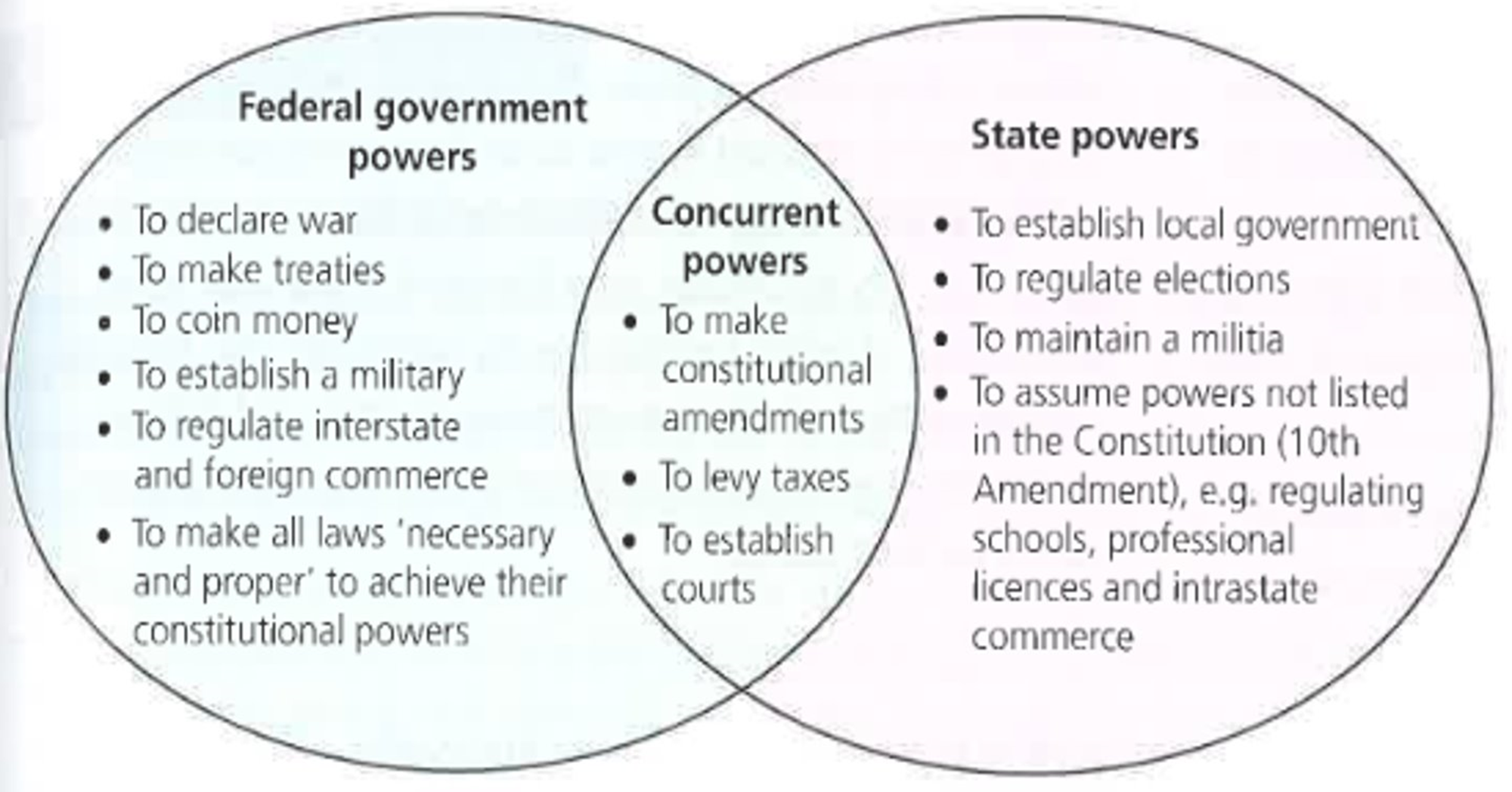
Dual Federalism or Layer Cake Federalism
There are different levels of Government (federal, state, government) each with clearly defined roles. The roles do not overlap. Most of American history has had Dual Federalism. 1780s-1920s
Cooperative Federalism or Marble Cake Federalism
Layers of government are intertwined. A product of the Great Depression and President Franklin D Roosevelt
The Federal Government encourages State and Local governments to fulfil the Federal government's aims. 1930s-1960s. ‘Carrot and Stick’
Phase 1 of Federalism
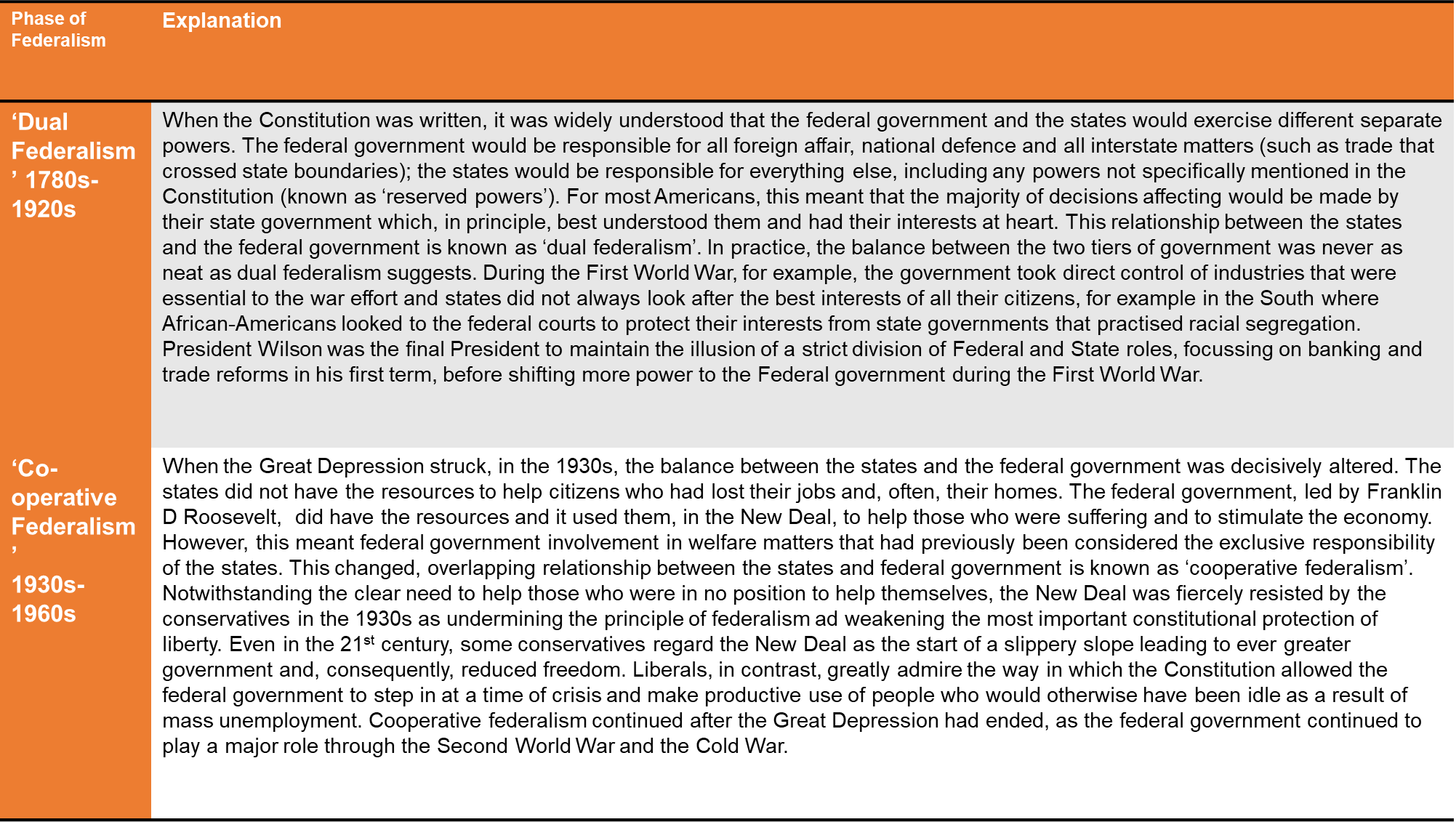
Phase 2 of Federalism
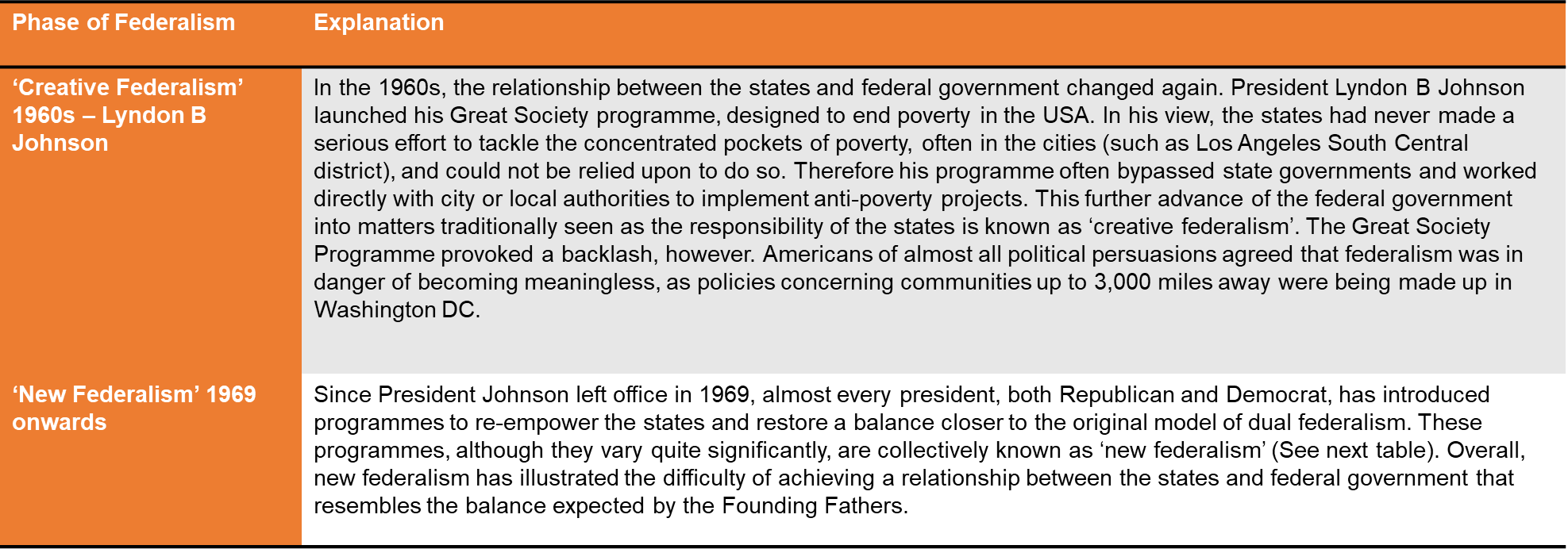
Why has federalism taken so many forms?
The reason that federalism has taken so many forms is that none has worked effectively. The only time that the states have enjoyed a resurgence has been during an economic boom. Whenever there has been a national crisis, the federal government has either chosen to assert dominance over the states or has been required to do so, often with the full backing of states that have been powerless to cope with events.
All presidents since Johnson have tried to give power back to the states (closer to ‘Dual Federalism’)
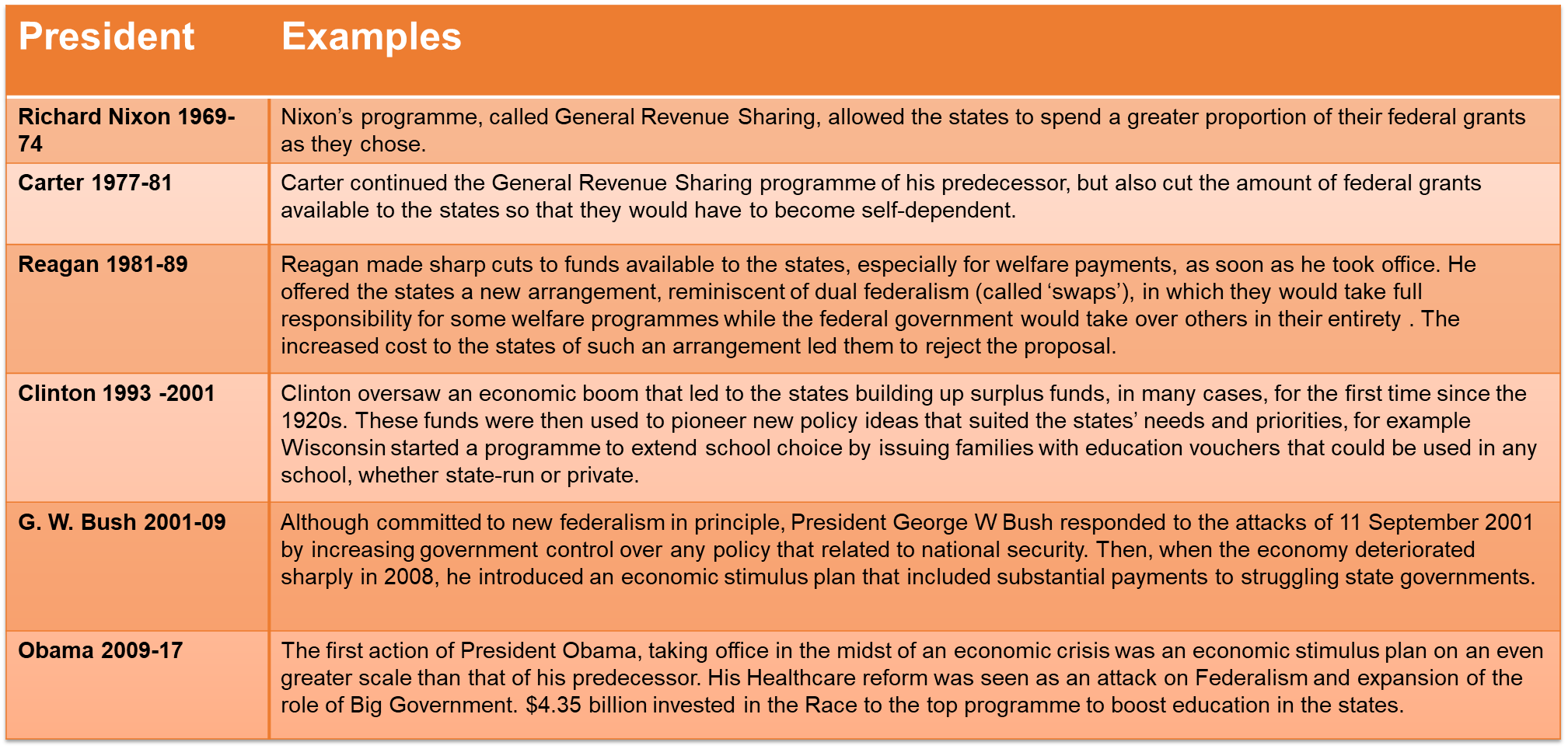
States are the ‘Laboratories of Democracy
Ideas are put into practice at state level
If they are successful then they are taken up by the federal government
Also, many states passing similar legislation can trigger the federal government to pass national legislation
Example of ‘Laboratories of Democracy’
Massachusetts health care reform became the Affordable Care Act
Women’s voting rights in Wyoming paved the way for national women’s suffrage
Many are predicting state laws legalising possession of marijuana will lead to National changes in drug legislation
Supreme Court pushes national power - McCulloch vs Maryland
1819 (very early in US history)
Supreme Court led by Chief Justice Marshall
Set precedent for national government taking priority over state governments in all areas which congress has power.
Why is federalism so hard?
Federalism creates unique tensions which are not part of a non-federal government. Some of these are practical, some are constitutional. Today we are looking at some of the practical problems created by cooperative federalism.
Balancing the state budget
49 of the 50 states have constitutions which require a ‘balanced budget’
This means state governments cannot spend more than they have coming in in taxes.
In most states this is in the constitution (think back to your work on proposed amendments, this was a popular suggestion in congress at a federal level)
A budget deficit is where you spend more than you have in income.
Money offers a solution and a problem for Federalism
States have strict sending rules. This means they rely on federal funding to afford things. The federal funding may change depending on who is in the White House or approving budgets in Congress. This means the money is unreliable. However, there is no solution as most state constitutions ban the state borrowing money and the US Constitution specifically mandates the federal government to do this. Almost all industrialised nations run at a deficit.
The market is bad for the states
Large companies can take advantage of the states when they are divided up, there is always another state who will offer a better environment for business.
Federalism is difficult because..
State rely on the federal government for money but this funding is not consistent.
Breaking up the states gives each one less power to negotiate with multinational companies. The people get a worse deal.
It’s not functioning as the framers intended.
What sort of federalism did Reagan support?
New Federalism
He was president in 1984. Made states raise drinking age to 21 or have a 10% decrease in budget for road maintenance This was passed by Congress
Wyoming had the 10% for two years, then changed their drinking age
An example of how cooperative Federalism works and New Federalism hasn’t been consistently pursued by presidents